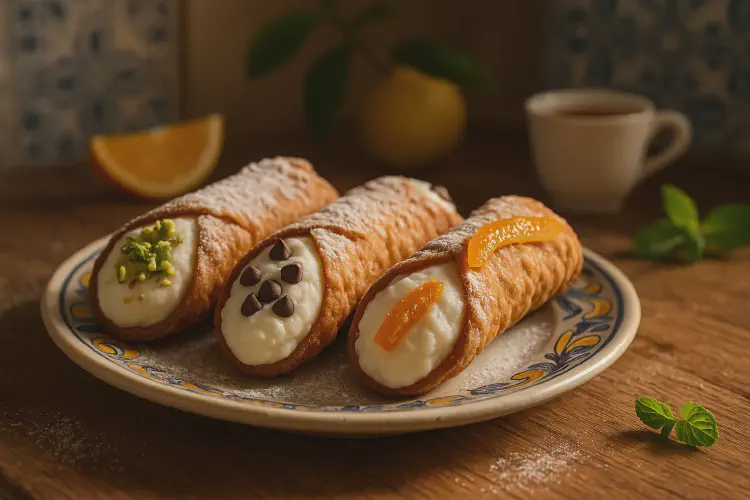Sicilian desserts: cannoli, cassata, granita
Sicily’s desserts are as colorful and rich as its history. Influenced by **Arab, Norman, and Spanish** cultures, Sicilian sweets combine creamy ricotta, citrus, almonds, and candied fruit into edible works of art. The island’s most iconic trio — **cannoli, cassata, and granita** — captures the essence of Sicily: indulgent, sunlit, and unforgettable.
- Visit Sicily
- 3 min read

Sicilian Desserts: Cannoli, Cassata, and Granita — Sweet Symbols of the Island
🍰 Overview
Sicilian desserts tell a story of cross-cultural exchange and celebration. The Arabs introduced sugar, almonds, and citrus; the Normans brought dairy; and the Spanish added chocolate and cinnamon. These influences fused into sweets that are both luxurious and comforting — enjoyed in pastry shops, festivals, and family kitchens across the island.
🥖 1. Cannoli Siciliani
The most famous Sicilian dessert, cannoli are crisp pastry tubes filled with sweetened ricotta cheese, often decorated with candied orange peel, chocolate chips, or pistachios.
- Origin: believed to have Arab roots, originally prepared during Carnival as a symbol of fertility and joy.
- The shells are deep-fried until golden, while the filling is made from sheep’s milk ricotta, sugar, and vanilla.
- Variations: in Palermo, cannoli are filled to order for freshness; in eastern Sicily, pistachio cream or chocolate may be added.
Must-try: Cannoli from Piana degli Albanesi near Palermo, famous for their artisanal ricotta.
🎂 2. Cassata Siciliana
A masterpiece of Sicilian pastry art — colorful, intricate, and full of symbolism.
- Made with sponge cake soaked in liqueur, layered with sweet ricotta, and covered in marzipan and candied fruit.
- The exterior features green almond paste and bright decorations, reflecting Arab and Baroque influences.
- The name cassata likely derives from the Arabic qashata, meaning “bowl.”
- Originally an Easter dessert, it’s now enjoyed year-round in celebrations.
Regional variations:
- Cassata al forno: a simpler baked version with pastry crust, typical of Palermo.
- Modern versions: mini cassatine covered in icing or chocolate.
🍧 3. Granita Siciliana
A refreshing frozen dessert made with water, sugar, and natural flavorings.
- Originated from Arab sherbet traditions adapted by Sicilian snow collectors (nivaroli) who stored Etna’s ice.
- Unlike sorbet, granita has a grainy, crystalline texture and is less sweet.
- Served with a brioche col tuppo — a soft, round brioche bun perfect for dipping.
Popular flavors:
- Almond (mandorla): rich and nutty.
- Lemon (limone): tart and refreshing.
- Coffee (caffè): intense, often topped with whipped cream.
- Pistachio (pistacchio): creamy and luxurious, especially in Catania.
Best enjoyed: for breakfast in eastern Sicily — especially in Catania, Acireale, and Taormina.
🍬 Other Sweet Highlights
While cannoli, cassata, and granita are the stars, Sicily’s dessert world offers many more gems:
- Frutta Martorana: marzipan molded and painted to look like real fruit.
- Minne di Sant’Agata: dome-shaped cakes from Catania filled with ricotta and covered in white icing.
- Buccellato: ring-shaped Christmas cake with figs, almonds, and honey.
- Cubbaita: traditional almond nougat with sesame and honey.
☕ Perfect Pairings
- Espresso or almond milk pairs perfectly with cannoli or cassata.
- Marsala wine complements ricotta-based desserts.
- Granita pairs beautifully with morning sunshine and sea views.
🧭 Summary
Sicilian desserts are more than sweets — they’re cultural icons. Cannoli celebrate joy, cassata embodies artistic beauty, and granita offers cool relief under the Mediterranean sun. Together, they represent the island’s enduring creativity and its talent for turning simple ingredients into moments of pure happiness.